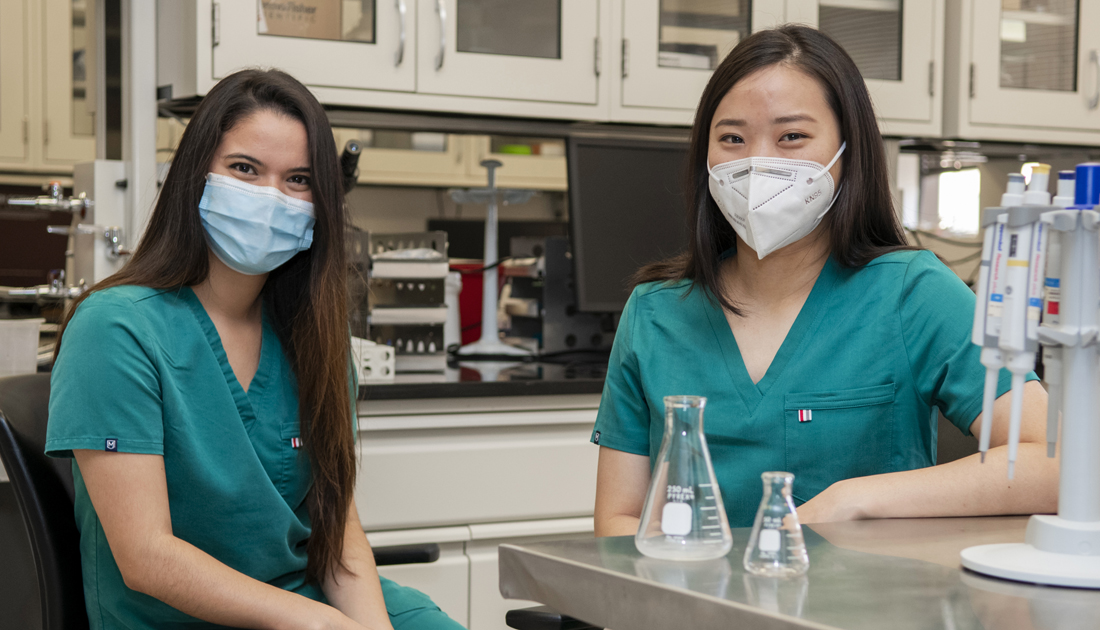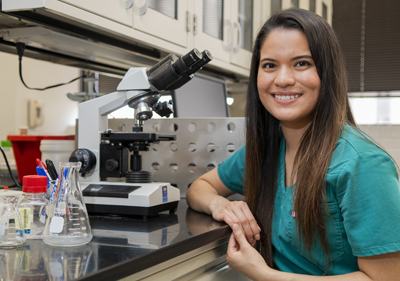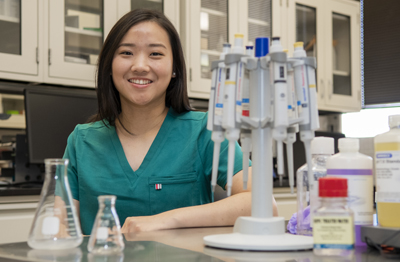Rethinking COVID-19

Allowing COVID-19 to derail their summer research wasn’t an option. Instead, these dental students and their mentors turned the tables on the new coronavirus and made it their research focus.
Students Andrea Carrizales and Jordan Chen delved into COVID-related public health issues, procuring useful data for the dental community. As part of Texas Retains and Recruits, a four-year grant that includes student stipends for summer research, this group of four summer researchers was embedded in the pre-existing Predoctoral Student Research Program offered through Texas A&M College of Dentistry’s Office of Research.
Traditional student research had ground to a halt this summer as social distancing limited access to labs, but a scaled-down virtual approach allowed these TRR students to tackle their research anyway. The grant calls for a focus on social determinants of public health, and the timing couldn’t have been more perfect.
“That’s how COVID research is a natural fit,” says Dr. Peggy Timothe, assistant professor in public health sciences and a principal investigator for the TRR grant. “Even though it’s an infectious disease and all, in terms of the outcome it’s having on populations, it really varies depending on where people live, their race and ethnicity, their age … all are key issues of social determinants of health.”

Carrizales and Chen’s projects honed in on how COVID-19 has affected dental patients and providers, both nationwide and in Texas. Carrizales addressed “States’ Response to COVID-19 in the Dental Setting.” Chen focused on “Evaluating Adult Dental Medicaid During COVID-19.”
TRR co-investigator Anneta Bitouni, clinical assistant professor in comprehensive dentistry, guided Carrizales as she explored how states were handling state and national COVID-19 guidelines and recommendations—including those from the Centers of Disease Control and Prevention, the Occupational Safety and Health Administration, and the American Dental Association—regarding the provision of dental care during the pandemic.
“Access to oral health care—a social determinant of health—was disturbed,” says Bitouni, a board-certified dental public health specialist. “Evaluation of individual states’ guidelines in regards to dental settings and how they compared to the national organizations’ recommendations gave us insight into what is done on a state and national level in order to re-establish access to oral health post-COVID-19.”
Carrizales, now a first-year dental student, says she was intrigued by how dental practices adjusted to reopening as stay-at-home orders were lifted. As a dental assistant herself, she had received guidelines via email from the Texas State Board of Dental Examiners. She wondered whether professionals in other states were receiving similar guidance.
Her research looked into six categories affected by COVID-19, including how dental practices responded to pre-appointment offerings, office readiness and procedure guidelines. Office readiness adjustments included creating a safer office environment by having patients wait for appointments outside instead of in waiting rooms, implementing social distancing, disinfecting surfaces and more. Pre-appointment guidelines—screening for COVID, offering teledentistry, postponing elective procedures—also were assessed. Procedure guidelines included using dental dams, minimizing aerosol generation and limiting the number of people per work area.
“In some states, the guidelines were OK but weren’t complete or didn’t agree with ADA, CDC and OSHA guidelines,” she says. “They’re trusting dentists to behave professionally and do their own research. But providing specifications actually makes it easier for the provider to know what is expected of them, to deliver care that is safe and in accordance to guidelines.”
Compared to other states, Texas scored well in nearly all categories except one: pre-appointment screening guidelines, which included recommendations to delay preventative appointments. Carrizales says these findings raised concerns about continuous oral health care, which becomes problematic as both dentists and patients cancel their appointments due to COVID-19 concerns.
“It’s so easy to put it off, and then in six months you don’t even go again. Before you know it, it’s already been a year,” she says.
Chen’s research honed in on COVID-19’s impact on adult Medicaid in 10 broad areas, including emergency coverage, dental benefits, maximum per-person spending, procedures covered, out-of-pocket costs, changes implemented, teledentistry, personal protective equipment (PPE) reimbursement and advocacy for change.

Chen, also a first-year dental student, says she has always been interested in health care coverage for the disadvantaged community, so gathering related research data further piqued her interest.
“Medicaid is already an interesting and complicated topic, and when you add an unprecedented public health emergency with COVID-19 to the mix, it becomes even more so,” she says.
As of July 2020, Chen’s research found teledentistry coverage impacted the most as more states turned to technology for virtual checkups. Before COVID-19, only 13 states covered teledentistry. Once the pandemic hit, a total of 37 states ramped up teledentistry.
For PPE reimbursement, very few states covered the extra expense; a few covered other costs instead. Data from 14 states was inconclusive.
In Texas, adult Medicaid only covers emergency care, “which in a time like this has not allowed for much change,” she says. Coping with the coronavirus was only exacerbated by the state’s limited coverage. Expanding that coverage would be a solid first step in moving forward, especially during unprecedented emergencies like a pandemic.
Chen says one of her biggest takeaways was the shifting emphasis to teledentistry. However, states’ teledentistry offerings varied wildly, with Texas lagging behind many others.
Similar to the passing of the CARES Act on March 27, 2020, Chen’s findings call for national changes, such as expanding COVID-19 testing and investing in telehealth. Recommendations for states include improving access to personal protective equipment, expanding teledentistry and enhancing Medicaid funding during a pandemic, specifically for adults with underlying health conditions.
Both Carrizales and Chen hope their research will open up a discussion for improvements that could help ready the dental profession should another pandemic or national emergency arise.
Carrizales hopes to present her research at the National Oral Health Conference in Orlando, Florida, next April. Chen’s project was selected to be presented at the Student Competition Advancing Dental Research competition in Boston next July with her mentor, Dr. Shirley Lewis-Miranda, clinical assistant professor in comprehensive dentistry, and also a TRR grant co-investigator. Miranda says she is still working with Chen on how best to present to advocacy groups.
“Public health and oral health are important issues in our community, and what I’ve learned from my mentor and oral health advocates is that we need to continuously advocate for change,” Chen says.